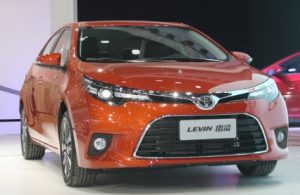 China is facing a challenge similar to the U.S. – how to get car shoppers to buy more clean vehicles and less gas guzzling pollution emitters like large SUVs. While plug-ins, or “new energy vehicles,” have taken off in sales during the past couple of years, China’s regulatory and incentive structure appears to be changing toward a broader definition of clean vehicles. Toyota and a few Chinese automakers and suppliers are asking the government to support plug-less hybrids as another way to reduce tailpipe emissions and dependence on imported oil
China is facing a challenge similar to the U.S. – how to get car shoppers to buy more clean vehicles and less gas guzzling pollution emitters like large SUVs. While plug-ins, or “new energy vehicles,” have taken off in sales during the past couple of years, China’s regulatory and incentive structure appears to be changing toward a broader definition of clean vehicles. Toyota and a few Chinese automakers and suppliers are asking the government to support plug-less hybrids as another way to reduce tailpipe emissions and dependence on imported oil
In 2013, incentives in China for purchasing plug-in electrified vehicles (PEVs), along with electric buses, jumped up while hybrid electric vehicle subsidies were cut. The definition of new energy vehicle changed exclusively to PEVs as previous new energy incentives for plug-less hybrids were cut.
That may change course as the government is considering mandating policy requiring 25% of new vehicle sales to be plug-less hybrids by 2030, according to comments made last week by Ouyang Minggao, who leads a group that China’s auto industry regulator commissioned to set targets for energy-saving vehicles. The report recommends increasing hybrid sales to 8% of total passenger vehicle sales by 2020, and then up to 20% by 2025 and one quarter of sales by 2030.
China is also considering extending a tax cut beyond the end of this year for small-engine cars with up to 1.6 liter engines, an industry ministry official said last week. That move could help sustain a sales rebound in small, fuel-efficient vehicles in the world’s largest auto market.
China requires automakers to lower the average fuel consumption of their vehicles to 5 liters per 100 kilometers by 2020 from the current 6.9 liters. New energy vehicles will play a part, but now China may be looking to hybrids and small cars to help hit the fuel consumption and emissions targets. This year has seen a steep increase in large SUV sales in China as gasoline prices stay down and consumers with more spending power find SUVs appealing, similar to what’s been seen in the U.S. market. That puts more pressure on China to meet emissions and fuel economy goals.
Subsidies to manufacture and purchase PEVs have made a huge difference in the market. Through September, China came close to selling as many cumulative PEVs as the U.S. has seen since they first appeared in the market in late 2010; with the U.S. total at 522,519 cumulative PEVs sold and China finishing the month at 521,649 sold. At the end of 2012, China had only seen 27,800 PEVs sold, with dramatic sales surges seen in 2014 and 2015. If electrified buses were to be included in the total, China would be clearly the world’s leader with 733,447 new energy vehicles sold through the end of 2015, according to HybridCars. Generous government incentives are considered to be a big part of rapid growth in China’s PEV sales.
Earlier this year, the Chinese government announced plans to cut 2017-2018 new energy/plug-in vehicle subsidies by 20% from those granted in 2016, and 2019-2020 subsidies will be 40% less than this year. These subsidies will stop after 2020, the government said. Instead, China will support development of a points-based credit system similar to that used in California to encourage production and use of new-energy vehicles.
Cutting PEV subsidies may be exacerbated by a scandal reported in September on rule violations by several vehicle manufacturers. Five Chinese bus makers were penalized by the government for taking about 1 billion yuan ($150 million) in illegal subsidies for new energy vehicles. Soon after, an additional 20 automakers were called out for violating these rules. These included global automakers Nissan and Hyundai, and Chinese makers Geely, JAC Motor, and a subsidiary of electric carmaker BYD.
The China Association of Automobile Manufacturers changed its forecast for PEV orders to 400,000 from 700,000 vehicles, down 43 percent, last month. China’s top auto industry association slashed its forecast of new energy vehicles that will be ordered this year as the government subsidy scandal widened.
Manufacturers such as Zhejiang Geely Holding Group Co. and Hunan Corun have been lobbying the Chinese government to increase support for development of plug-less hybrids. Hunan Corun supplies batteries for Toyota’s China-built hybrids.
Toyota has made the argument in China that hybrid technology could be more widely accepted by consumers as a solution.
Toyota plans to bring a hybrid version of its RAV4 sport utility vehicle to market in China as soon as possible, Matsumoto Shinichi, executive vice president of Toyota’s local engineering and manufacturing unit, said prior to the Beijing auto show earlier this year. The Japanese automaker plans to localize the development and production of hybrid SUVs in China, after introducing its Corolla and Levin hybrid compact cars late last year for a 2018 introduction, including plug-in hybrid variations.
